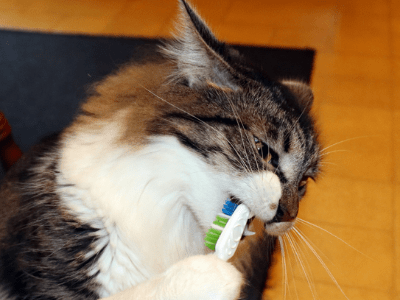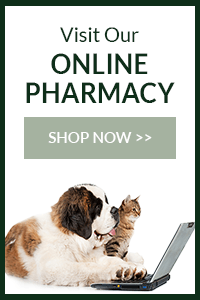Your co-worker brought in tuna salad for lunch. Again. Now she’s trying to discuss the latest developments at work with you, and she’s standing a little too close for comfort. You’re not hearing a word she says as you hold your breath and try to think of a subtle way to get her out of your bubble.
No one wants to be near another human with bad breath. And while we love our onion bagels in the morning, we always make sure to pop an Altoid afterwards. We find bad breath in humans to be unpleasant, so why is it that we consider bad breath in pets to be normal? Dental hygiene is one of the most overlooked areas of pet health — over half of all cats and dogs in the United States have periodontal disease. Taking care of your fur baby’s mouth and teeth isn’t as hard as it may seem! Today we’d like to give you some simple ways to keep up with your pet’s dental needs. 🦷
*Allow 5 minutes to read.
No one wants to be near another human with bad breath. And while we love our onion bagels in the morning, we always make sure to pop an Altoid afterwards. We find bad breath in humans to be unpleasant, so why is it that we consider bad breath in pets to be normal? Dental hygiene is one of the most overlooked areas of pet health — over half of all cats and dogs in the United States have periodontal disease. Taking care of your fur baby’s mouth and teeth isn’t as hard as it may seem! Today we’d like to give you some simple ways to keep up with your pet’s dental needs. 🦷
*Allow 5 minutes to read.
At every annual wellness exam, your veterinarian should do a thorough oral exam of your pet’s mouth, teeth and gums. Your vet will be able to monitor plaque development on your pet’s teeth, as well as any red flags like gum inflammation, tooth resorption, or infection. This is such an important preventative measure! By staying on top of dental health, you and your vet can make sure to address any concerns early on, protecting your pet from some very painful conditions and saving you money in the long run.
Contrary to popular belief, bad breath is NOT okay for a pet. This usually points towards a build-up of tartar and plaque that should be removed, or even an infection or abscess. If your pet’s breath starts to smell funky, schedule a visit with your vet so that they can take a closer look.
Okay, so some of us have pets that won’t let us anywhere near their mouths. If you risk losing a finger whenever you get near your cat or dog’s face, maybe this precautionary step isn’t for you. Cats especially are known for their dislike of poking and prodding. For those of you with more cooperative pets at home, try to get in the habit of checking their gumlines (“flip the lip!” as your vet might say). Look for any redness, inflammation or bleeding. Bonus: if your pets get used to you putting your hands on their mouths, it will be MUCH easier to successfully brush their teeth! Which brings us to our next suggestion…
This is the singular best way to prevent plaque build-up on your pet’s teeth and thus minimize their need for dental cleanings. It’s best to start tooth-brushing when your dog or cat is young, so that this action becomes a normal part of their routine. Your vet can provide you with a toothbrush and toothpaste that are recommended for pets. Most dogs and cats won’t tolerate the taste of your minty Colgate (not to mention human toothpaste is NOT safe for animals), but a bacon- or chicken-flavored toothpaste might not be so bad to them. Your veterinarian can show you the easiest ways to brush your pet’s teeth and make sure you have everything you need to do so.
If your pet doesn’t like the bristle sensation of a toothbrush but will tolerate your finger in their mouth, dental wipes may be a better option. It only takes a few seconds to wipe one across your pet’s teeth to remove that icky biofilm.
There are also water additives and oral gels that you can use. These products help decrease the amount of bacteria in a pet’s mouth, which slows the development of the biofilm layer on the teeth, thus delaying plaque and tartar buildup.
If your pet doesn’t like the bristle sensation of a toothbrush but will tolerate your finger in their mouth, dental wipes may be a better option. It only takes a few seconds to wipe one across your pet’s teeth to remove that icky biofilm.
There are also water additives and oral gels that you can use. These products help decrease the amount of bacteria in a pet’s mouth, which slows the development of the biofilm layer on the teeth, thus delaying plaque and tartar buildup.
We love our pets and want nothing more than to spoil them rotten, right? Well if you’re going to indulge little Bella with a daily treat, you might as well make sure it’s a treat that promotes good dental health. Greenies are a wonderful choice and can be found at your local pet store, Fleet Farm, or online. OraVet is another great option and is developed specifically for veterinarians. Both of these treats are approved by the Veterinary Oral Health Council (VOHC) and are formulated to reduce tartar and clean a pet’s teeth as they’re consumed. You can find other approved dental treat options on VOHC’s website here.
If your furry companion goes ballistic when you attempt to brush their teeth, definitely make dental treats a priority. While these treats can’t replace the action of tooth-brushing, they certainly help! And we promise your fur babies won’t complain 😊
Side-note: Avoid giving your pets cooked bones or antlers to chew on! Chewing on these can fracture a pet’s tooth, resulting in the need for a tooth extraction or restorative work (both of which are costly!). A good rule of thumb is to bounce the bone on your knee — if it hurts to do so, don’t give it to Fido. 🦴
If your furry companion goes ballistic when you attempt to brush their teeth, definitely make dental treats a priority. While these treats can’t replace the action of tooth-brushing, they certainly help! And we promise your fur babies won’t complain 😊
Side-note: Avoid giving your pets cooked bones or antlers to chew on! Chewing on these can fracture a pet’s tooth, resulting in the need for a tooth extraction or restorative work (both of which are costly!). A good rule of thumb is to bounce the bone on your knee — if it hurts to do so, don’t give it to Fido. 🦴
If your pet doesn’t have any other specific dietary restrictions, a dental diet is a phenomenal way to protect their dental health long-term. We recommend Royal Canin’s Dental Diet. This is a nutritionally complete and balanced diet that comes in canine and feline versions and helps prevent plaque and tartar build-up. If you don’t want to switch your pet over to a new food, the Dental Diet kibbles can be added to your pet’s daily meals or given as a treat.
Every breed is different, and some are more at risk for dental disease than others. Some breeds (like dachsunds) are genetically predisposed to dental disease.
Small-breed dogs with smaller mouths like Yorkies and Maltese tend to have overcrowding in their mouths. Brachycephalic breeds like Pugs, Shih Tzus, Persians and exotic cats also experience overcrowding and rotated teeth due to the conformation of their jaws. Overcrowding can contribute to plaque and tarter build-up.
Cats tend to develop dental resorption and stomatitis more than dogs. Both of these issues are very painful for a pet, and can be quite pricey to resolve. For more information about tooth resorption, check out our website.
Regardless of the species or breed, a pet can develop severe kidney, heart and liver conditions if dental issues aren’t addressed. Dental disease also can make it harder to regulate feline and canine diabetes. The take-home message is this: pet wellness begins with a healthy mouth!
Small-breed dogs with smaller mouths like Yorkies and Maltese tend to have overcrowding in their mouths. Brachycephalic breeds like Pugs, Shih Tzus, Persians and exotic cats also experience overcrowding and rotated teeth due to the conformation of their jaws. Overcrowding can contribute to plaque and tarter build-up.
Cats tend to develop dental resorption and stomatitis more than dogs. Both of these issues are very painful for a pet, and can be quite pricey to resolve. For more information about tooth resorption, check out our website.
Regardless of the species or breed, a pet can develop severe kidney, heart and liver conditions if dental issues aren’t addressed. Dental disease also can make it harder to regulate feline and canine diabetes. The take-home message is this: pet wellness begins with a healthy mouth!
Dental problems are common with pets, especially if owners aren’t familiar with preventative measures like the ones we’ve listed above. By keeping up with a few extra steps like monitoring gum appearance and breath odor, giving dental-specific treats and/or food, and brushing your pet’s teeth at least once per week, you can make sure your pet have healthy (and pain-free) mouths. For more information about our dental services, visit our website here.








